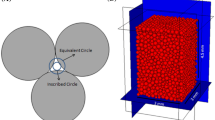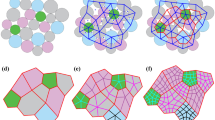Abstract
Porosity is a critical textural parameter in the complex nature of rock and while it has the highest impact on the strength of intact rock, in the case of oil and gas reservoir rocks, it defines the capacity and permeability of the reservoir. A constant value for triaxial strength factor (mi) of rock failure criterion has been given for each type of sedimentary rocks such as sandstone and the effect of porosity on the mi has not been well defined. Rock is not a homogenous material as with varying the porosity, the other inherent variables also control the strength and the mechanical behavior. Rock porosity varies in a wide range in sedimentary rocks such as sandstone. In this study, the effect of porosity on the parameters of failure criteria (mi) for rock-like materials made from cemented grains is investigated. For sample preparation, a mixture of cement-sand-water was compacted with variable water content to obtain specimens having a wide range of porosities using the same grain size of filler material. Two types of grains including sand and silica filler material were used for the experimental program. Sixteen sets of artificial specimens having porosities from 9.00% to 34.09% have been prepared for two filler materials of sand and silica, while other factors affecting the strength have been kept constant. The triaxial strength test results of these specimens show that the triaxial strength factor (mi) of Hoek et al. failure criterion, internal friction angle (ϕ), and cohesive strength (C) significantly decrease with increasing the porosity. The best-fit curves follow power function with high coefficients of regression.

















Similar content being viewed by others
References
Al-Homadhi ES and Hamada GM (2001) Determination of petrophysical and mechanical property interrelations for simulated sandstone rocks. Proc. 6th Nordic symposium on petrophysics. 15-16 May 2001, NTNU, Trondheim, Norway
Bineshian H (2014) Failure and post-failure aspects of mechanical response of concrete structures to compression and tension. MSc Thesis, School of Civil and Environmental Engineering, University of Western Australia
Bineshian H, Ghazvinian G, Bineshian Z (2012) Comprehensive compressive-tensile strength criterion for intact rock. J Rock Mech Geotech Eng 4(2):140–148
Boggs SJ (2009) Petrology of sedimentary rocks, 2th edn. Chapter 4. Cambridge University Press, Cambridge, pp 129–134
Brady BHG, Brown ET (2005) Rock mechanics for underground mining, 3rd edn. Springer, Berlin, p 645
Dunn DE, LaFountain LJ, Jackson RE (1973) Porosity dependence of mechanism of brittle fracture in sandstones. J Geophys Res 78(14):2403–2417
Eysa EA, Ramadan FS, El Nady MM, Said NM (2016) Reservoir characterization using porosity–permeability relations and statistical analysis: a case study from North Western Desert, Egypt. Arab J Geosci 9. https://doi.org/10.1007/s12517-016-2430-x
Griffith AA (1920) The phenomena of rupture and follow in solids. Philos Trans R Soc Lond A 221:163–198
Griffith AA (1924) The theory of rupture. Proceeding of First International Congress of Applied Mechanics, ed. By Biezeno C.B and Burgers J.M: 54–63
Gu D and Mostyn GR (1991) The study of a method of making equivalent material modeles. 2nd International Symposium of Mining Technology and Science, Zusbou, China
He P-f, Kulatilake PHSW, Dong-qiao L, He M-c (2017) Development of a new 3-D coal mass strength criterion. Int J Geomech 17(3):04016067. https://doi.org/10.1061/(ASCE)GM.1943-5622.0000741
He P-f, Kulatilake PHSW, Xuxu Y, Dong-qiao L, Man-chao H (2018) Elaborative comparison of nine intact rock strength criteria using polyaxial intact coal strength data obtained through PFC3D simulations. Acta Geotechnica Int J 13(2):419–445. https://doi.org/10.1007/s11440-017-0566-9
Hobbs DW (1966) Scale model studies of strata movement around mine roadways. Int J Rock Mech Min Sci 3:101–127
Hoek E, Wood D and Shah S (1992) A modified Heok-Brown failure criterion for jointed rock masses. Eurock 1992, London, Thomas Telford, pp 209-214
Indraratna B (1990) Development and application of synthetic material to simulate soft sedimentary rocks. Geotechnique 40(2):189–200
ISRM (1979) Suggested methods for determining the uniaxial compressive strength and deformability of rock materials. Int J Rock Mech Min Sci Geomech Abstr 16:135–140
Johnston IW, Choi SK (1986) A synthetic soft rock for laboratory model studies. Geotechnique. 36(2):251–263
Katz AJ, Thompson AH (1986) Quantitative prediction of permeability in porous rock. Phys Rev B 34(11):8179–8181
Kulatilake PHSW, Liang J, Gao H (2001a) Experimental and numerical simulations of jointed rock block strength under uniaxial loading. ASCE J Eng Mech 127(12):1240–1247
Kulatilake PHSW, Malama B, Wang J (2001b) Physical and particle flow modeling of jointed rock block behavior. Int J Rock Mech 38(5):641–657
Laskaripour GR and Passaris EKS (1995) Correlations between index parameters and mechanical properties of shale. Proc. 8th Congress of ISRM, Tokyo, 11, pp 257–261
Li D, Liu X, Liu X (2015) Experimental study on artificial cemented sand prepared with ordinary Portland cement with different contents. J Mater 8:3960–3974. https://doi.org/10.3390/ma8073960
Mampitiyarachchi DKDS (1982) Some factors influencing properties of Hawkesbury sandstone. Ph.D. Thesis, The University of New South Wales, Sydney, Australia
Marinos P and Hoek E (2000) GSI-a geologically friendly tool for rock mass strength estimation. Proc. GeoEng Conference, Melbourne. Invitedpapers, Vol. I. Technonic Publishing Co., Inc., Pennsylvania, pp 1422–1440
Marinos P, Hoek E (2001) Estimating the geotechnical properties of heterogeneous rock masses such as flysch. Bull Int Assoc Eng Geol 60:85–92
Mehranpour MH, Kulatilake PHSW (2016) Comparison of six major intact rock criteria using a particle flow approach under true triaxial stress conditions. Int J Geomech Geophys Geo-energy Geo-Resources 2:203–229
Mehranpour MH, Kulatilake PHSW, Xingen M, He M (2018) Development of new three-dimensional rock mass strength criteria. Rock Mech Rock Eng J 51:3537–3561. https://doi.org/10.1007/s00603-018-1538-6
Moomivand H (2007) Effect of porosity on the estimating uniaxial compressive strength of sandstone using Schmidt hammer and investigation in to exhaustive relation between its mechanical properties. Research Project, Urmia University
Moomivand H (2011) Development of a new method for estimating the indirect uniaxial compressive strength of rock using Schmidt hammer. Journal of BHM Berg- und Hüttenmännische Monatshefte (Journal of Mining, Metallurgical, Materials, Geotechnical and Plant Engineering) 156(4):142–146
Palchik V (1999) Infuence of porosity and elastic modulus on uniaxial compressive strength in soft brittle porous sandstones. J Rock Mech Rock Eng 32(4):303–309
Rahimi R (2014) The effect of using different rock failure criteria in wellbore stability analysis. MSc Thesis in Petroleum Engineering, Missouri University of Science and Technology
Rosenblad JL (1968) Development of rock-like material. Tenth US Symposium on Rock Mechanics: 331–361
Saucier KL (1967) Development of material for modelling rock. U.S. Army Engineer Waterways Experiment Station (Viskburg Mississippi). Miscellaneous Paper, No. 6–93, October
Shen J, Jimenez R, Karakus M, Xu C (2013) A simplified failure criterion for intact rocks based on rock type and uniaxial compressive strength. J Rock Mech Rock Eng 47:357–369. https://doi.org/10.1007/s00603-013-0408-5
Shi X, Cai W, Meng Y, Li G, Wen K, Zhang Y (2016) Weakening laws of rock uniaxial compressive strength with consideration of water content and rock porosity. Arab J Geosci. https://doi.org/10.1007/s12517-016-2426-6
Smorodinov MI, Motovilov EA and Volkov VA (1970) Determinations of correlation relations between strength and some physical characteristics of rocks. Proc Second Congress of ISRM, Belgrade, Privredni pregled, 2: 35–37
Stimpson B (1970) Modelling materials for engineering rock mechanics. Int J Rock Mech Min Sci 7:71–121
Vernik L, Bruno M, Bovberg C (1993) Empirical relations between compressive strength and porosity of siliciclastic rocks. Int J Rock Mech Min Sci Geomech Abstr 30(7):677–680
Vutukuri VS and Katsuyama K (1997) Introduction to rock mechanics, Industrial Publishing and Consulting, Inc. Tokyo, pp 275
Acknowledgments
The authors of this paper would like to thank Mr. V Mohebi technical officer of Rock Mechanics laboratory of Urmia University for his continual assistance in manufacturing devices for modeling specimens.
Author information
Authors and Affiliations
Corresponding author
Additional information
Editorial handling: Pinnaduwa Kulatilake
Rights and permissions
About this article
Cite this article
Amiri, M., Moomivand, H. Development of a new physical modeling method to investigate the effect of porosity on the parameters of intact rock failure criteria. Arab J Geosci 12, 317 (2019). https://doi.org/10.1007/s12517-019-4494-x
Received:
Accepted:
Published:
DOI: https://doi.org/10.1007/s12517-019-4494-x




